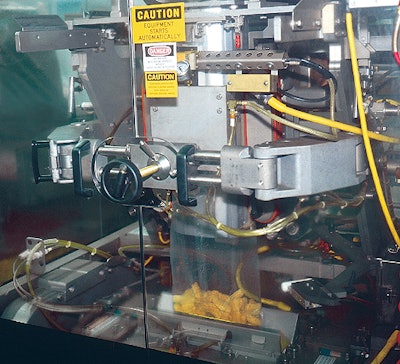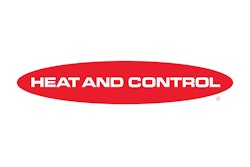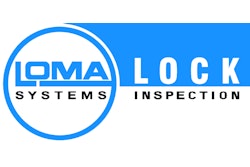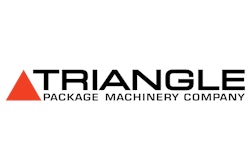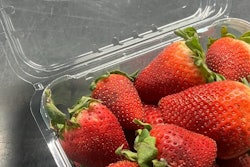Until late 2001, Janes Family Foods was limited to 40 bags/min production on its individually quick frozen (IQF) chicken produced at the company’s North York, Ontario, Canada plant. In fact, Janes even had to make two separate product dumps for some of its larger products because its older vertical form/fill/seal machine’s scale buckets couldn’t handle them in a single fill.
“We had to get creative and dump half of the product load into a bag, then add the other half of the product fill,” recalls plant manager Leonard Cole. “We had small buckets on the machine that did not allow us to fill larger-sized packages in a single fill. So the process was time-consuming and very restrictive. We had put the machine in back in 1990, and it worked real hard for us, but it was becoming an old klunker. We wanted to upgrade our scales and filling process and make them faster.”
Janes began searching for new equipment in 2001. “In our selection process, we had many choices,” Cole recalls. “We wanted to get the best bagger that could fill at rates upwards of 90 a minute, and buy the best weigher. We did a thorough investigation of the equipment that was available, and we sent our product to some of the vendors that make the vertical form/fill/seal equipment,” he notes. “Some of the equipment didn’t work out so well.” The equipment that rose to the top was an Advantage CM Model B5PR from Triangle Package Machinery (Chicago, IL).
“We had not used Triangle equipment before, but we knew a lot of companies had them and their people had good things to say about the machines,” Cole acknowledged during a recent Packaging World plant visit. “The Triangle is more robust, and its sealing jaws move in a simple D-shaped pattern,” which he says is more efficient than the former machine. “Triangle proved they could make bags at the speeds we were looking to achieve.”
Janes made the decision to top the Triangle with a 14-head Ishida scale system from Heat and Control (Hayward, CA). “Each scale has a top accumulation bucket with a weigh bucket and load cell below. It’s an extremely accurate scale system that handles everything from our 350-g (12.35-oz) size up to a 2ꯠ-g (70.6-oz) bag,” says Cole.
From processing to packaging
At North York, Janes receives boneless chicken, then cuts, seasons, forms, breads, and “par-fries” it before the pieces are quick frozen. The pieces are conveyed through a spiral freezer for about 30 minutes before they’re conveyed into the Ishida scale system.
“The system works fast to check the weights in the different buckets, usually dumping chicken from three or four buckets to accurately meet the fill,” says Cole. “We have about 50 different SKUs that we fill on the equipment, though the Triangle allows us to store up to 250 different sizes. We run the line at speeds up to 90 bags a minute, depending on the bag size.”
Chicken falls from the buckets into a tube of 2-mil film, which is heat-sealed at the bottom. Because the bags are later packed into a printed folding carton, Janes uses unprinted film. The food-grade high-density polyethylene film withstands freezing and provides moisture resistance, according to Cathy Noel-Gonsalves, Janes’ procurement specialist, packaging and ingredients. The film is supplied by Direct Plastics Group (Brampton, Ontario, Canada).
“We used to source film from different suppliers,” Cole says, “but we found there were inconsistencies from roll to roll in terms of thickness, so we’d have to adjust sealing temperatures on the bagger to compensate for those differences. This film has been really consistent.”
A film unwind motor powers the film through dancer rollers, where it receives a Julian date code from a SmartDate® thermal-transfer coder supplied by Markem (Keene, NH). Film continues over a forming collar and is pulled downward by stepper motor-driven side belts past a heated channel that creates a back lap seal along the continuous tube of film.
The film tube continues to the servo motor-driven cross-seal assembly that is synchronized with the side belts. The jaws close on the film tube at the top of their smooth D-shaped cycle to seal the film tube at its bottom.
When the fill is complete, the sealing jaws simultaneously seal the top of the filled bag and the bottom of the next bag. The cut-off cycle is actuated with a knife that cuts through and between the sealed area. The sealing jaw assembly opens and then returns to the top of its cycle for the next bag.
Meanwhile, the filled-and-sealed bag drops onto an inclined conveyor that carries it through a new Combo 7000 combination metal detector/ checkweigher from Loma Systems (Carol Stream, IL). Bags continue to an accumulation table where they’re hand-packed into the folding cartons that are automatically set up, then closed on separate carton forming and sealing machinery (see Packworld.com/go/c061). Cartons are then manually placed into outer shipping cases that are stacked by hand onto a pallet before an older rotary stretch wrapper unitizes them for storage and shipment.
A winning combination
The significant production gains created by the speed improvements of the new vf/f/s-and-scale combination have created an impressive savings for Janes Family Foods. Cole explains, “With the slower equipment we used to have, we had to run it more often, and that led to considerable labor costs for overtime. With the new equipment, we’ve eliminated those overtime charges, and that saves us about $300ꯠ per year.”
Cole says another saving attributable to the scales is that it’s “reduced product giveaway by about three percent,” though he couldn’t attach a financial figure to those savings.
“The Triangle machinery is very good,” Cole says. “We have a nice setup with them where we can hook up to a modem and they can look at what’s happening with our equipment. It’s a dedicated phone line, and they can see situations where we change things. We make use of that system.” Personnel in Triangle’s engineering and service groups can monitor and troubleshoot through the modem-equipped vf/f/s machine, which is controlled by a Triangle Selectech system.
Comparing the fill-speed differences between the new and old vf/f/s units, Cole says, “we run our 350-gram pack at 90 a minute now, our two-pound pack at up to 60 a minute now. Before we were limited to 40 a minute on all our sizes. Now we fill our larger bag at one time, and no longer have to split it into two dumps.”
Cole says, “We run the equipment on two daily shifts, five or six days a week, depending on the season. The machinery has paid for itself in a little over a year. With the Triangle bagger and the Ishida scale, we think we have a combination that gives us the best of both worlds.”
